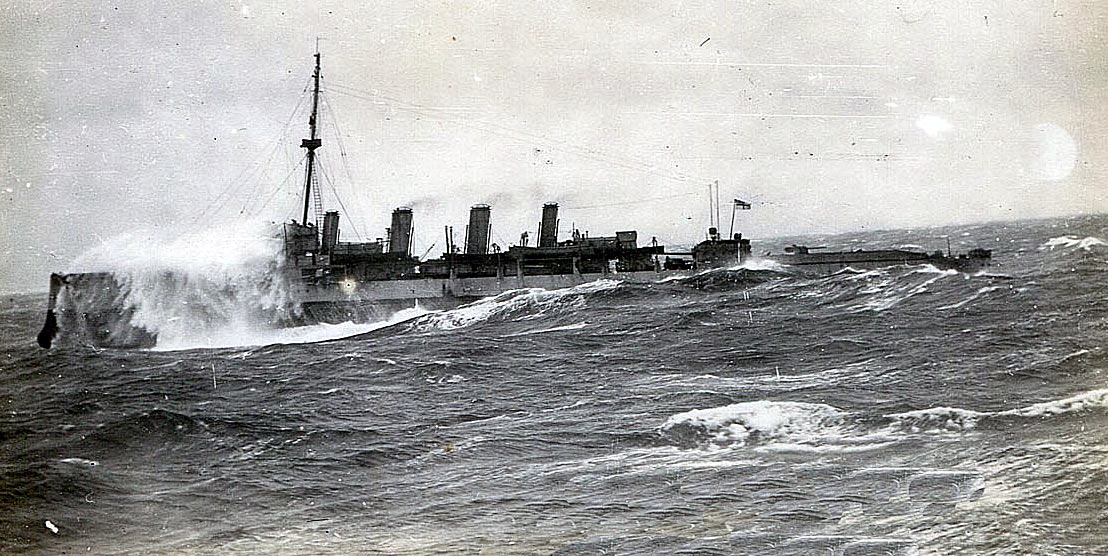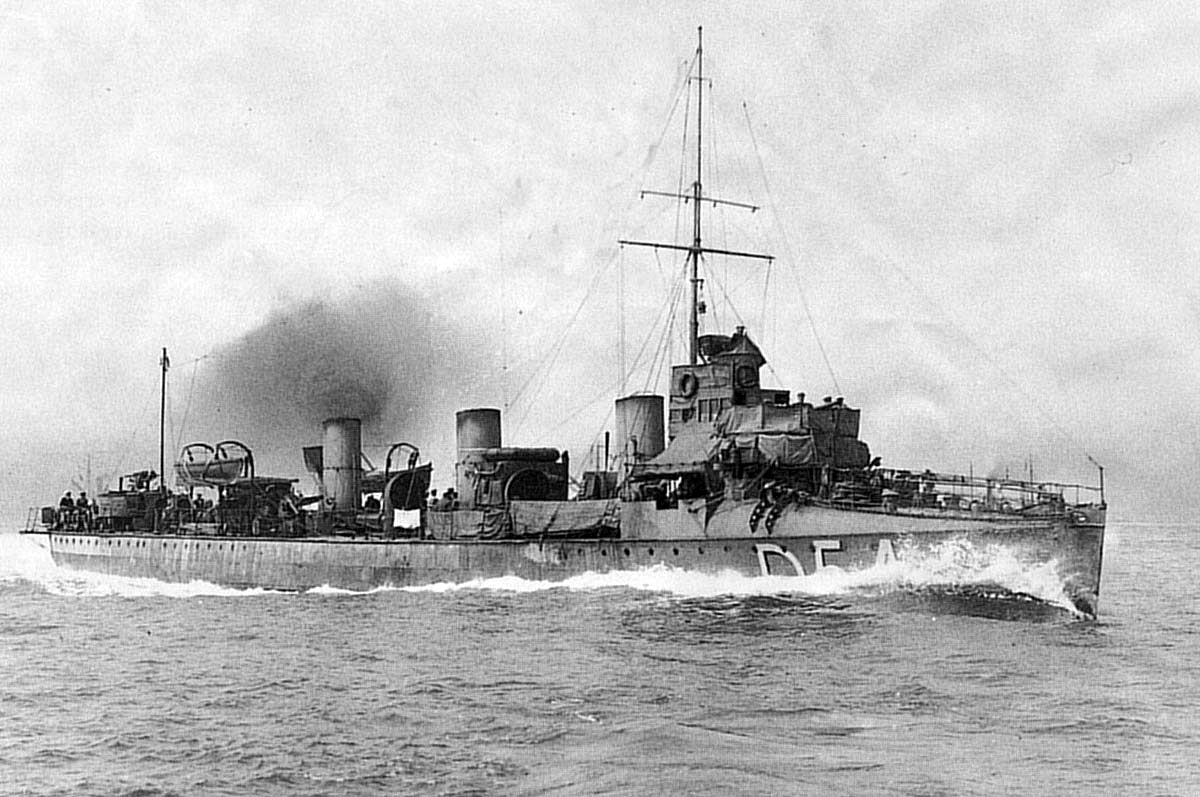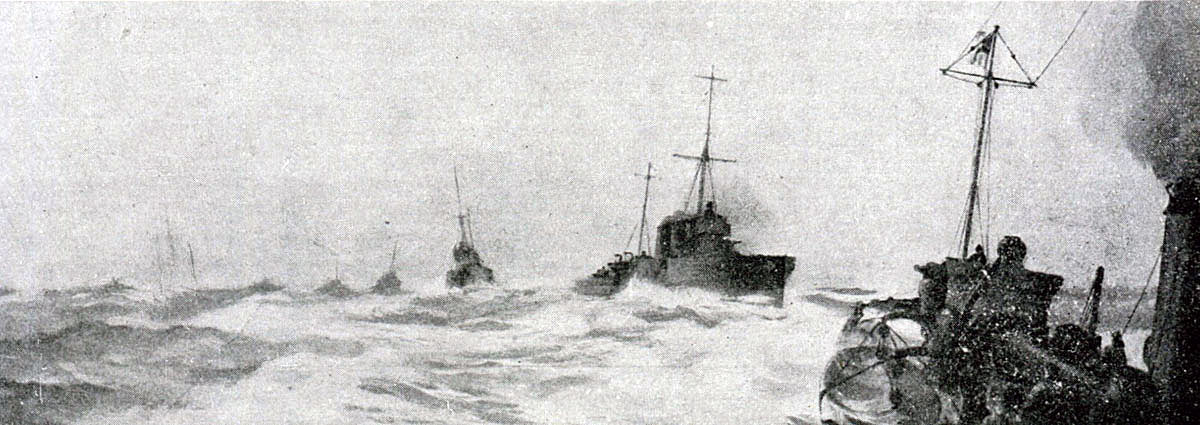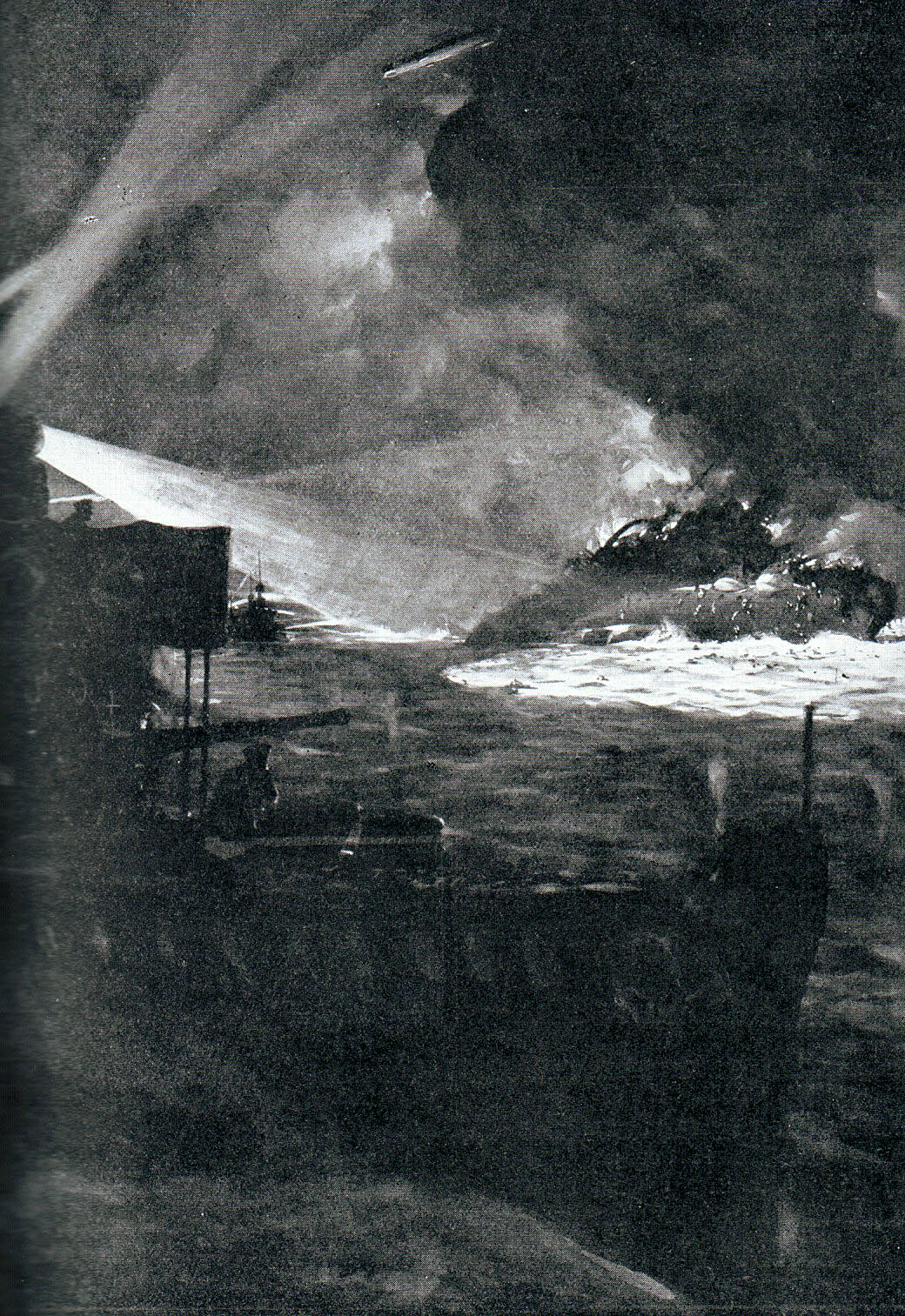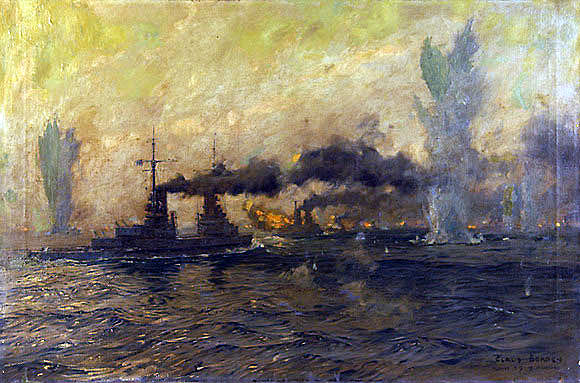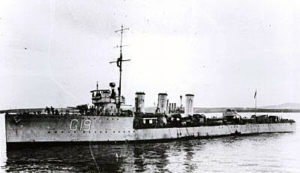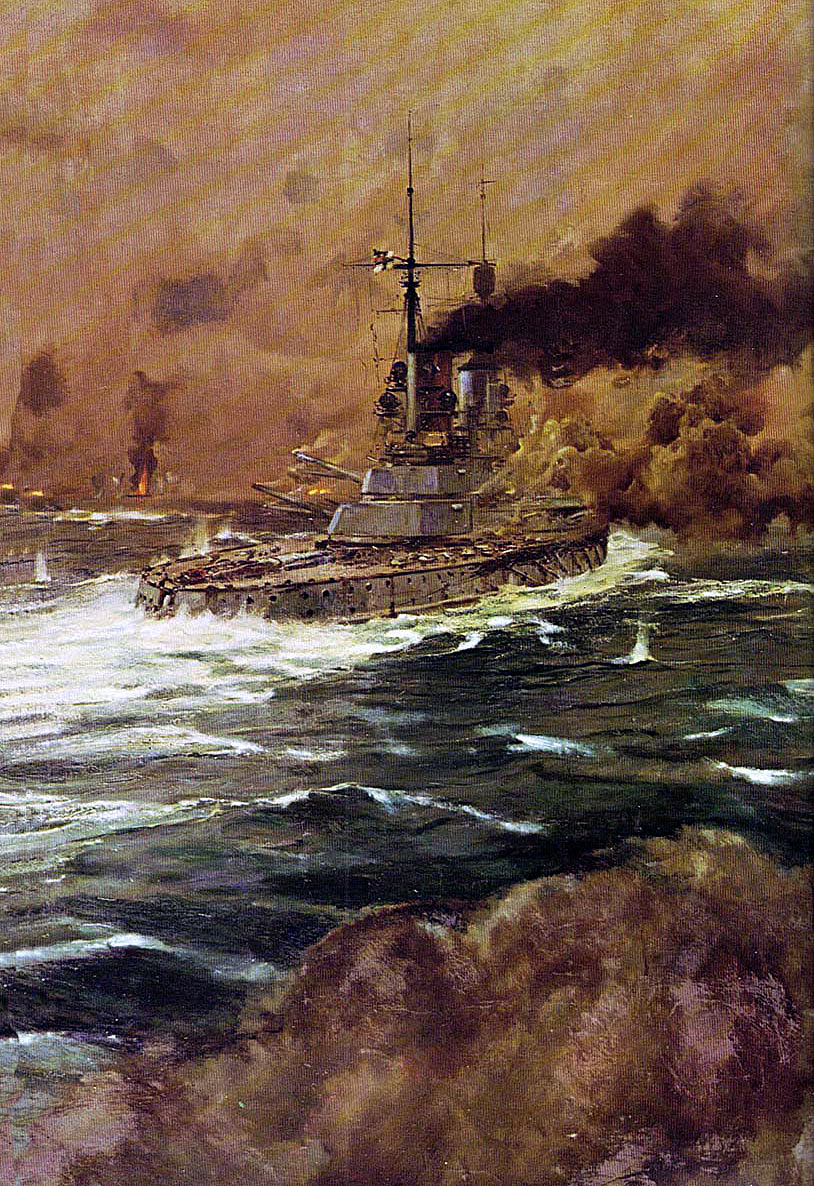The Titanic struggle between the British Grand Fleet and the German High Seas Fleet on 31st May 1916
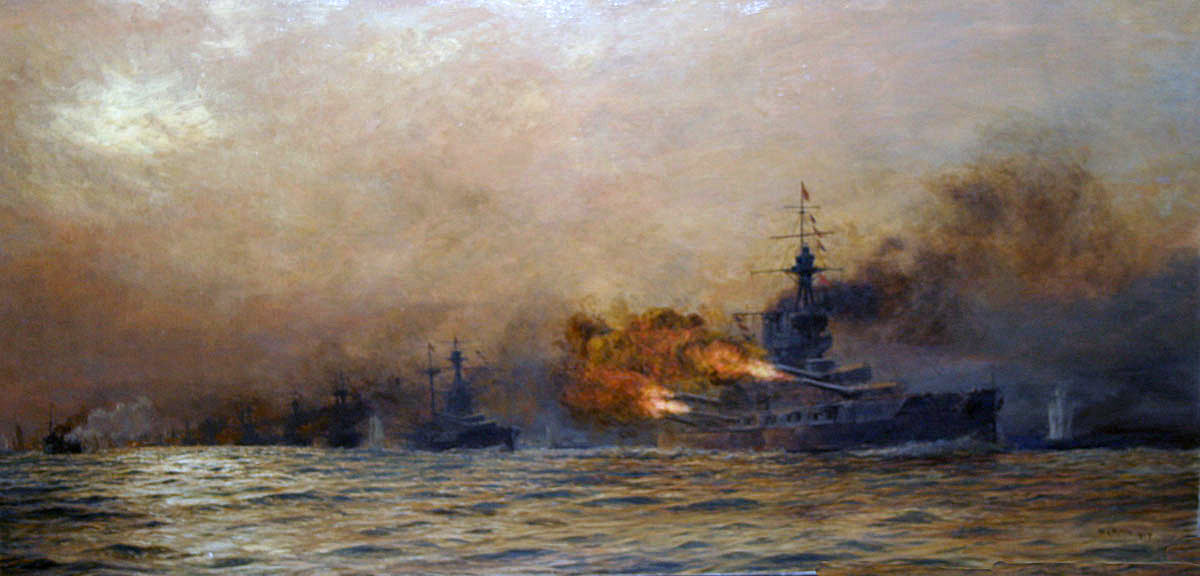
HMS Iron Duke Admiral Jellicoe’s Flagship opening fire at approximately 6.15pm on 31st May 1916 at the Battle of Jutland. Iron Duke is followed by other British Battleships. The ship on the extreme left of the picture is the disabled British destroyer HMS Acasta: picture by Lionel Wyllie
The previous battle of the First World War is the Battle of Jutland Part III: Clash between British and German Battle Fleets during the evening 31st May 1916
The next battle of the First World War is the Battle of Jutland Part V: Annexe
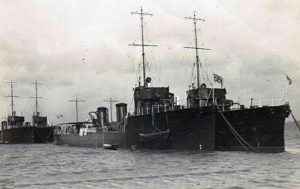
British Destroyers in Harbour, HMS Fortune with Ambuscade at the front. Both ships fought at the Battle of Jutland on 31st May 1916
Date: 31st May 1916
Place: In the North Sea off the coast of Denmark
War: The First World War
Contestants: The British Royal Navy against the Imperial German Navy
Admirals: Admiral Sir John Jellicoe commanded the Royal Navy’s Grand Fleet. Vice Admiral Sir David Beatty commanded the British Battle Cruiser Fleet. Admiral Reinhard Scheer commanded the German High Seas Fleet. Vice Admiral Franz Hipper commanded the German Battle Cruiser Squadron.
The opposing fleets: See The Battle of Jutland Part I
Winner:
The German navy considered it won the Battle of Skagerrak, the German name for Jutland, having sunk more Royal Navy ships and inflicted more casualties. The Royal Navy considered that it had repelled the incursion by the High Seas Fleet into the North Sea. The German fleet made only one further incursion during the War.
The Night Action 31st May/1st June 1916:
At the end of the fleet action during daylight hours on 31st May 1916 the German High Seas Fleet steamed away to the south-west under cover of a thick smoke screen and a torpedo attack delivered against the British battle line by the German destroyers both of which masked the direction of the German withdrawal.
During the night of 31st May to 1st June 1916 Jellicoe and the British battleships headed south with the destroyers behind, the battle cruisers to the fore and the light cruisers to the west.
The German fleet now heading in a south easterly direction was on a converging course with Jellicoe’s ships.
At around 9.30pm Admiral Scheer, commanding the German High Seas Fleet, renewing his attempt to break through to the east and the route to his home harbours, caused his leading ships to turn to port on course for the Horn Reefs off the Danish coast.
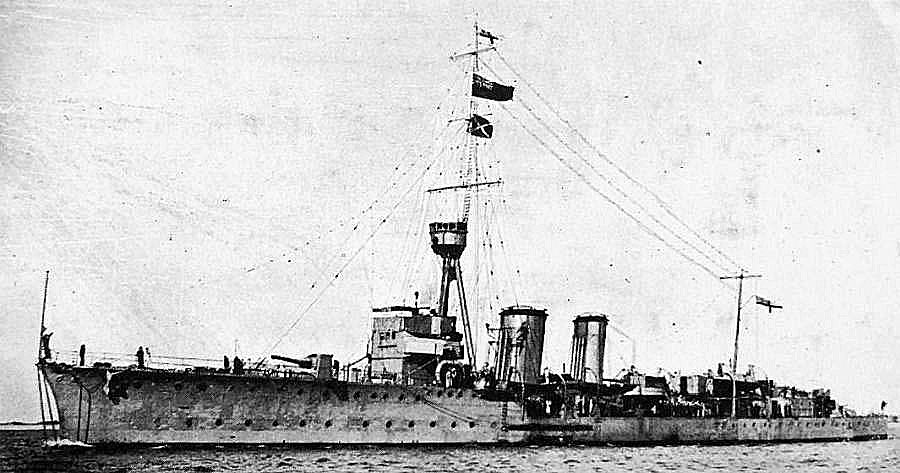
British Flotilla Leader HMS Castor. Castor fought at the Battle of Jutland 31st May 1916 leading the 11th Destroyer Flotilla
The leading German light cruisers quickly came into contact with the British rear-guard starboard wing, the light cruiser HMS Castor and destroyers of the 11th Flotilla.
The British ships were in some doubt as to the nationality of the ships approaching them on their starboard bow. On being challenged the strange ships signalled one correct response and two incorrect. The dilemma was resolved when the German light cruisers switched on their searchlights and opened fire at 2,000 yards (1 ¼ miles).
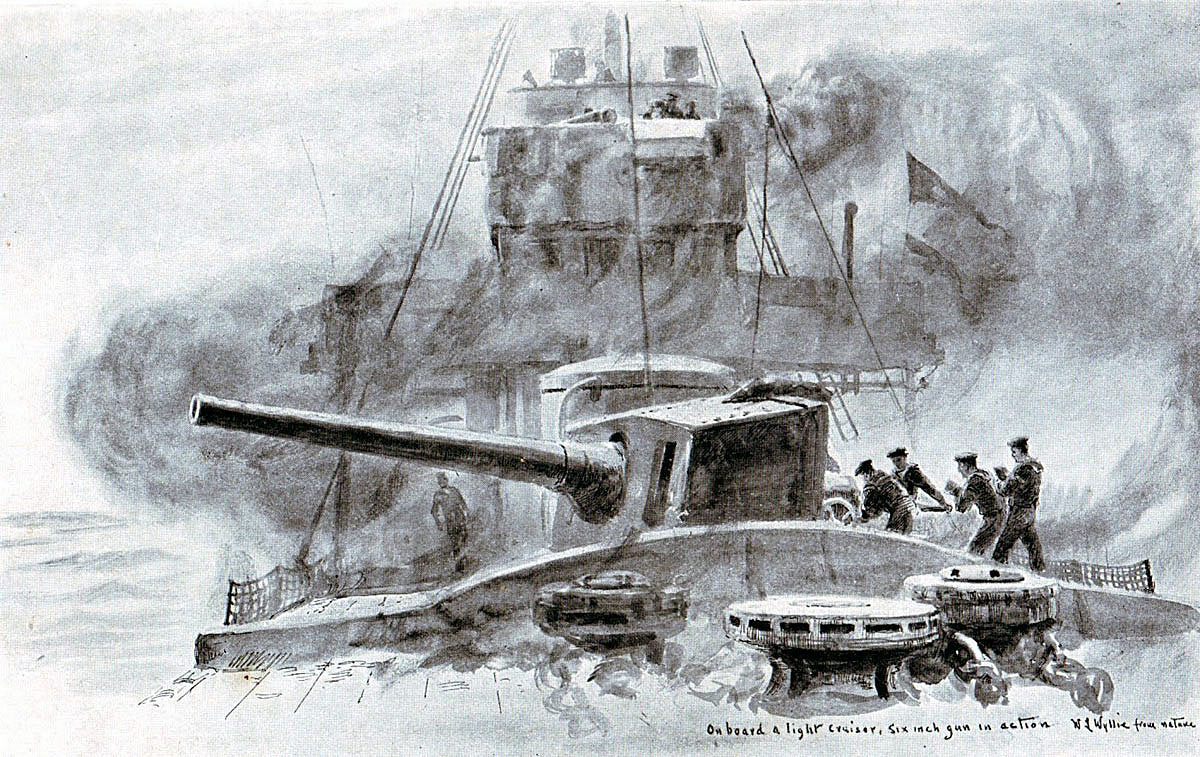
Gun Crew in action on a British Light Cruiser at the Battle of Jutland 31st May 1916: picture by Lionel Wyllie
Castor was immediately hit and set on fire. She turned away firing a torpedo. The following British destroyers Marne and Magic also fired torpedoes. Several British destroyers refrained from firing in the belief that the ships on the flank were British. The German ships turned away and in the confusion each side lost sight of the other.
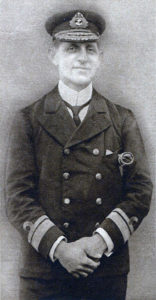
Commodore Goodenough commander of the 2nd Light Cruiser Squadron at the Battle of Jutland 31st May 1916
At 10.06pm, on receiving his cruisers’ reports of the action, Scheer turned a point to starboard thinking that this was a deliberate attack by the British destroyers. This change of course put him back on the converging course with the British fleet.
The next British ships Scheer’s fleet encountered were the light cruisers of Commodore Goodenough’s 2nd Light Cruiser Squadron which were escorting the battleship HMS Marlborough, reduced by torpedo damage to 16 knots.
Goodenough was on the alert after the firing on his starboard beam involving Castor’s flotilla. The German light cruisers of the 4th Scouting Group (SMS Stettin, München, Frauenlob, Stuttgart and Hamburg) appeared against the faint glow that was all that was left of sunset.
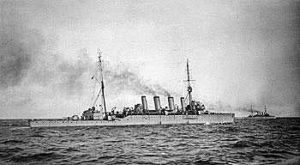
British Light Cruiser HMS Southampton. Southampton fought at the Battle of Jutland 31st May 1916 as Commodore Goodenough’s Flagship in the 2nd Light Cruiser Squadron
HMS Dublin and Southampton opened fire hitting German ships. Searchlights came on and Dublin and Southampton were deluged with fire from the German squadron at 800 yards (½ mile).
Nottingham and Birmingham kept their searchlights off and were not seen, enabling them to maintain a destructive fire unanswered.
Southampton, heavily damaged, managed to fire a torpedo which struck one of the German light cruisers. There was a flash. The German ships turned off their searchlights and disappeared into the darkness. The engagement had lasted fifteen minutes.
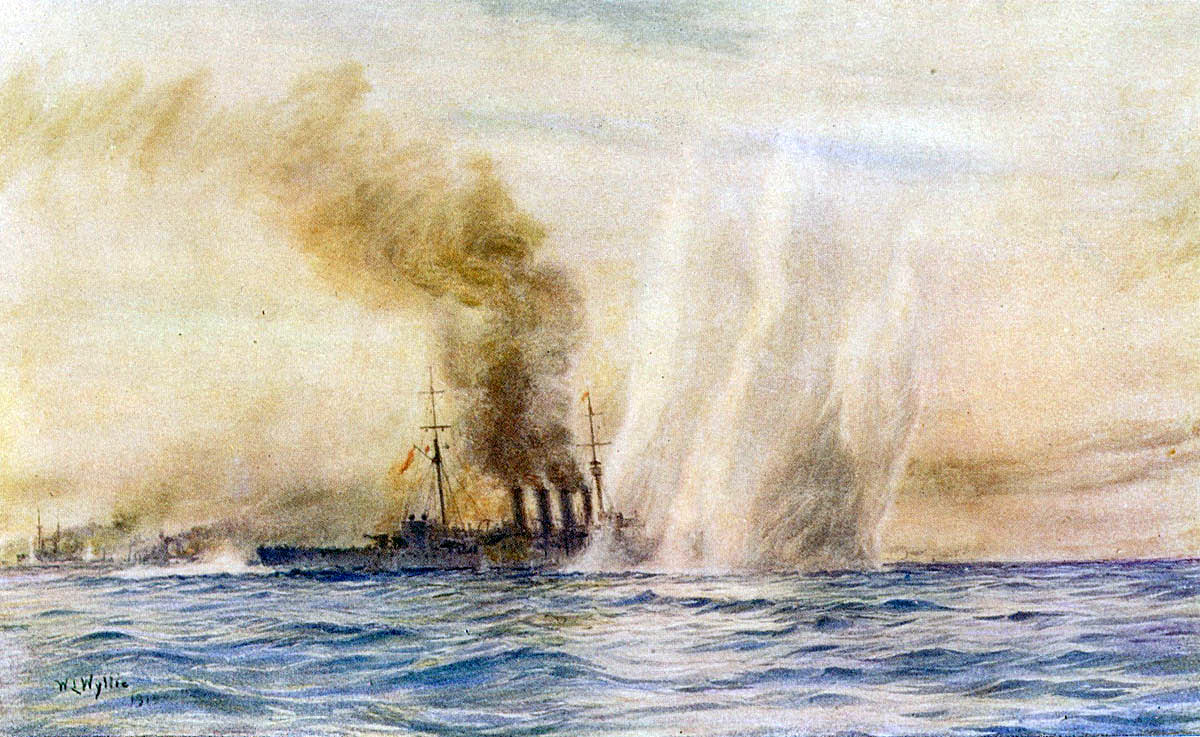
British Light Cruiser HMS Southampton during the night action at the Battle of Jutland 31st May 1916: picture by Lionel Wyllie
Southampton and Dublin were on fire with extensive casualties. Frauenlob sank with all hands at around 11pm.
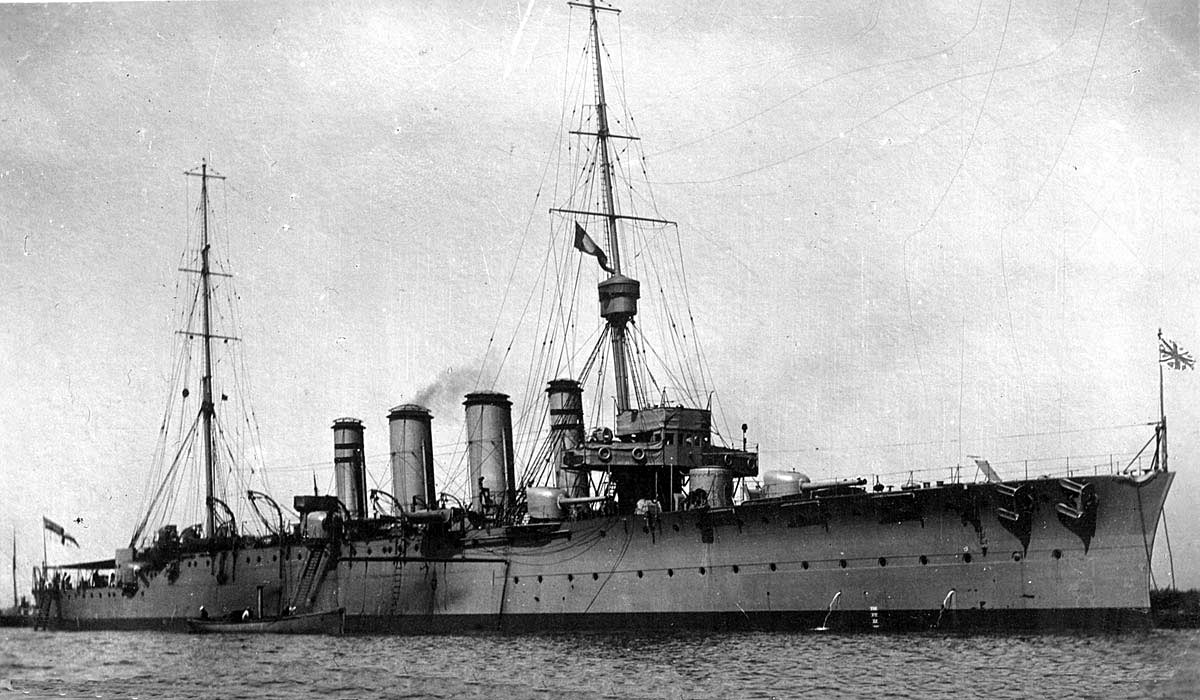
British Light Cruiser HMS Dublin. Dublin fought at the Battle of Jutland 31st May 1916 in Commodore Goodenough’s 2nd Light Cruiser Squadron
Goodenough gathered his squadron, less Dublin which became lost after losing her navigating officer and all her charts, and joined the 5th Battle Squadron, forming a rear guard against destroyer attack.
Although this action had been seen from Iron Duke Goodenough was unable to signal his report, the wireless on Southampton being destroyed, leaving Jellicoe unaware that the British ships had been engaging the van of Scheer’s fleet making its way across the British rear.
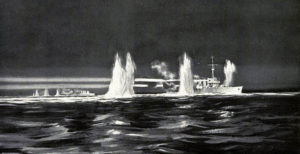
British 2nd Light Cruiser Squadron in action against the German High Seas Fleet during the night action Battle of Jutland 1916
Jellicoe had expected a torpedo attack by the German destroyers on his rear and he assumed this was the explanation for Goodenough’s sharp action. This view was confirmed by a report from one of Goodenough’s light cruisers that they had been engaging German light cruisers. Jellicoe took these to be in support of the destroyer attack rather than what they really were, the vanguard of the whole German High Seas Fleet. Jellicoe felt justified in continuing on his southerly course.
Other sightings of the German ships were made, one by the destroyer HMS Garland and another by the light cruiser HMS Boadicea attached to Admiral Jerram’s squadron. These were not reported to Jellicoe as the information was considered insufficiently important to justify breaking radio silence.
Jellicoe’s general instruction to his destroyer flotillas was intercepted by a German wireless listening station and passed to Scheer confirming to him that the British destroyers were to the rear of the battleship squadrons which were steaming south. Acting on this information Scheer altered course to approximately east of south-east and headed straight for the Horn Reefs light-ship in the expectation that he was now to the rear of Jellicoe’s battleships and clear of them.
Scheer’s 2nd Scouting Group (six light cruisers led by SMS Frankfurt) led the battle fleet in line ahead with some forty destroyers in a V formation in front. Many of the destroyers had fired all their torpedoes and were low in ammunition. Other destroyers were at the rear escorting the disabled Lützow.
Following the Castor action the German ships did not encounter any further British ships for the time being. This led Jellicoe to believe that the German Fleet was still to his west as he continued to steam south.
The British Fleet was becoming spread out and contact between components was breaking down. Admiral Burney’s Sixth Division was falling behind the rest of the battle fleet due to the damage to its flagship Marlborough. Beatty’s battle cruisers were some fifteen miles to the west screened by destroyers of the 1st and 4th Flotillas.
Beyond the British battle cruisers to the west were the 3rd and 1st Light Cruiser Squadrons, ordered to take position four miles on Beatty’s starboard beam. But the light cruisers were unable to see Beatty’s flagship HMS Lion and were consequently only able to act on Lion’s assumed position.
At 11.30pm the opposing fleets engaged again.
Night-time Destroyer Flotilla Actions:
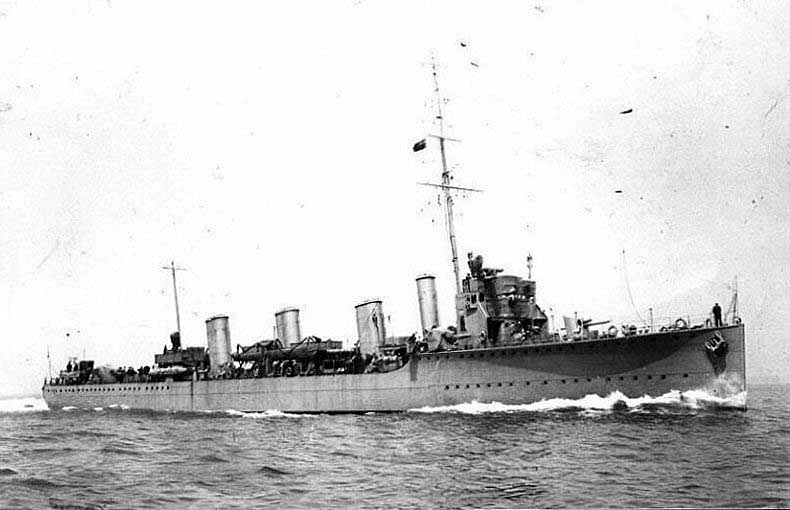
British Flotilla Leader HMS Tipperary. Tipperary was sunk at the Battle of Jutland 31st May 1916 leading the 4th Destroyer Flotilla
HMS Tipperary and Spitfire and the Fourth Flotilla attack:
Captain Wintour in HMS Tipperary was leading his 4th Flotilla nearest to the German ships. Some seven miles further east was the light cruiser Champion with the destroyers Termagent and Turbulent of the 10th Flotilla.
Next to the east were the four destroyers of the Harwich 9th Flotilla with Morris. Further east was the 12th Flotilla led by Faulknor.
At around 11.20pm Wintour became aware of shadowy ships on his starboard beam on a course converging with his own.
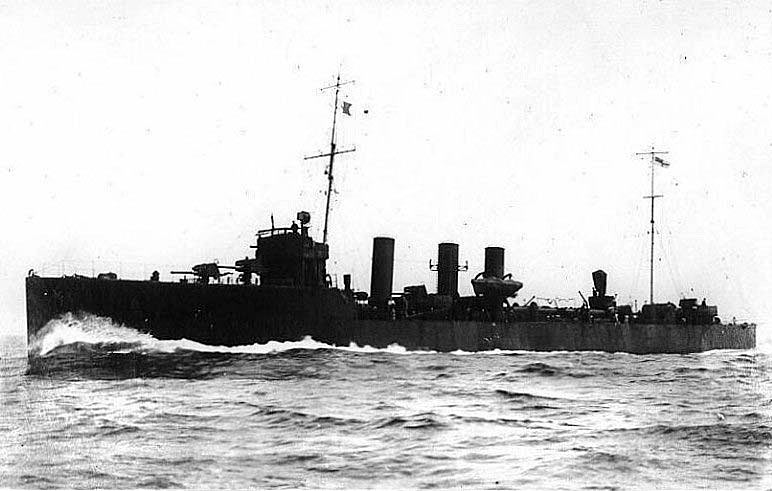
British Destroyer HMS Turbulent. Turbulent fought at the Battle of Jutland 31st May 1916 in the 10th Flotilla. She was run down by a German Battleship in the dark and lost with all hands
At a range of 1,000 yards (½ mile) Tipperary challenged the ships and immediately came under heavy fire at point blank range which left the ship a burning ruin, but not before she had discharged both her torpedo tubes at the German ships. HMS Broke and four of the destroyers also fired torpedoes, followed by the rest of the flotilla. The action was illuminated by the powerful searchlights on the German battleships and cruisers.
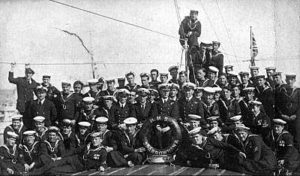
Crew of British Destroyer HMS Sparrowhawk. Sparrowhawk fought at the Battle of Jutland 31st May 1916 in the 4th Flotilla
The light cruisers of the German 2nd Scouting Group escaped the British destroyer attack by cutting through the line of battleships. The Elbing was rammed by the battleship Posen and later had to be abandoned.
Second in line to Tipperary was the destroyer Spitfire. As she tried to assist Tipperary a German ship bore down on her and the two ships rammed each other. Spitfire survived the encounter and limped home in spite of having been rammed by the German battleship Nassau. A large section of the Nassau’s armour was later found on Spitfire’s deck.
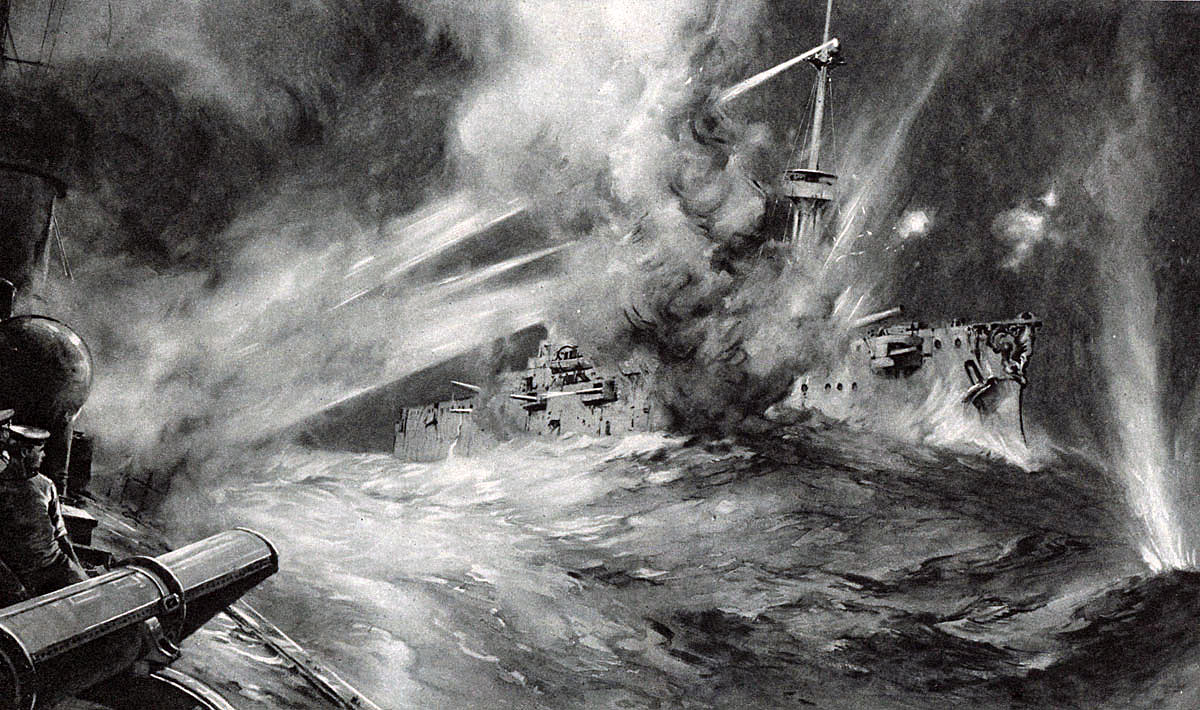
British Destroyer HMS Spitfire in action with German Battleship SMS Nassau Battle of Jutland 31st May 1916
The consequence of the British destroyer attack was that the van of the German fleet steered away to starboard on a course of south south-west to evade the uproar, a course which took the fleet away from its destination of the Horn Reefs.
Admiral Scheer on reaching the turning point eight minutes later peremptorily ordered the fleet to return to the course south-east by east towards the Horn Reefs.
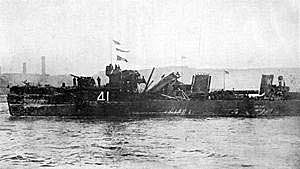
British Destroyer HMS Spitfire showing the damage she received at the Battle of Jutland 31st May 1916
HMS Broke took over from the wrecked Tipperary and led the remaining destroyers south to engage the German fleet anew.
At 11.40pm a large ship appeared on Broke’s starboard bow heading to cross Broke’s course. Broke challenged the ship with the familiar consequences; a blaze of searchlights from a number of German battleships and a hail of rapid fire at close range.
Broke swung to port to bring her torpedo tubes to bear but was immediately hit by a number of shells which put her out of control. Unable to steady after the turn Broke went round in a circle and rammed the following destroyer Sparrowhawk. Garland coming up behind managed to evade Sparrowhawk but the next destroyer Contest not seeing what had happened cut the stern off Sparrowhawk.
It seems that the German ships were the Westfalen battleships at the van of the German line.
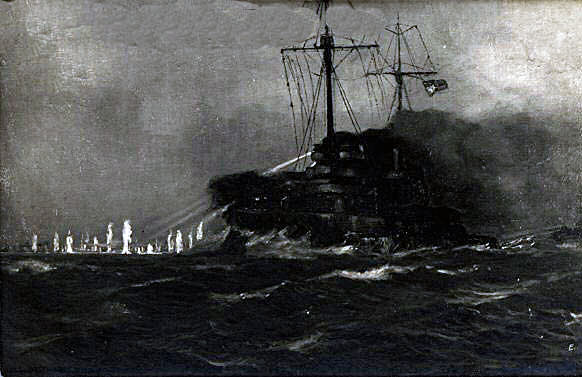
German Battleship SMS Westfalen firing on British Destroyers during the night action of the Battle of Jutland 31st May 1916
A British torpedo got home on the light cruiser Rostock, leading the German destroyers. Rostock withdrew from the area and was abandoned to sink by her crew.
With Broke and Sparrowhawk out of action Achates took over the lead of 4th Flotilla and led it south again.
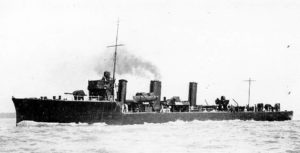
British Destroyer HMS Fortune. Fortune fought at the Battle of Jutland 31st May 1916 in the 4th Flotilla
The British destroyers soon again saw the looming shadows of the German battle fleet. They were too close for an attack to be launched and Achates and Ambuscade were forced away by German light cruisers, after Ambuscade had fired her last two torpedoes, circling round to the north-east to return to the scene.
The next two destroyers Ardent and Fortune attacked. A German light cruiser opened fire on Fortune setting her on fire. Ardent fired on the cruiser and discharged a torpedo which was thought to have struck the German light cruiser.
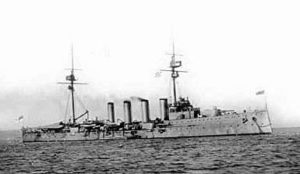
British Cruiser HMS Black Prince. Black Prince fought at the Battle of Jutland 31st May 1916 as part of Admiral Arbuthnot’s 1st Cruiser Squadron. Black Prince was sunk during the night with all hands
Fortune continued to fire her guns although now sinking. Porpoise attempted an attack on the German light cruiser but was struck by an eight inch shell which wrecked her, leaving the Ardent as the only ship of the flotilla capable of continuing in action.
HMS Black Prince:
Further south the heavy cruiser HMS Black Prince of Admiral Arbuthnot’s First Cruiser Squadron was making its way south to join the rest of the Grand Fleet after the destruction of the squadron earlier in the evening (HMS Defence sunk and HMS Warrior badly damaged and sinking, leaving Duke of Edinburgh and Black Prince).
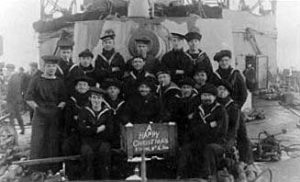
Members of the crew from HMS Black Prince sunk at the Battle of Jutland 31st May 1916 with all hands
Instead of coming up with the British Fleet Black Prince encountered the centre of the German battle fleet. Searchlights were switched on Black Prince and she was subjected to a storm of shellfire which left her in flames. Out of control the Black Prince sailed into the night, just missing the disabled destroyer Spitfire before exploding with the loss of her entire crew.
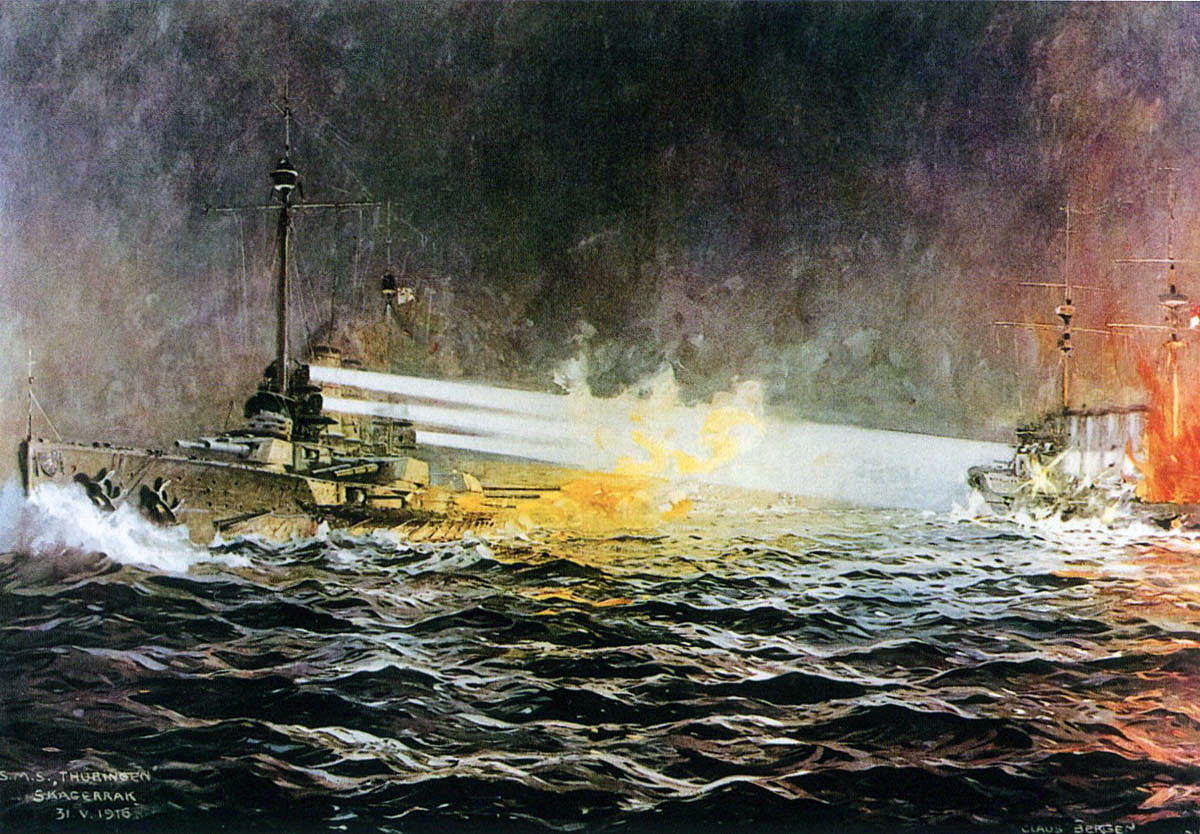
German Battleship SMS Thuringen attacks HMS Black Prince during the night of 31st May 1916 setting her on fire and sinking her: picture by Claus Bergen
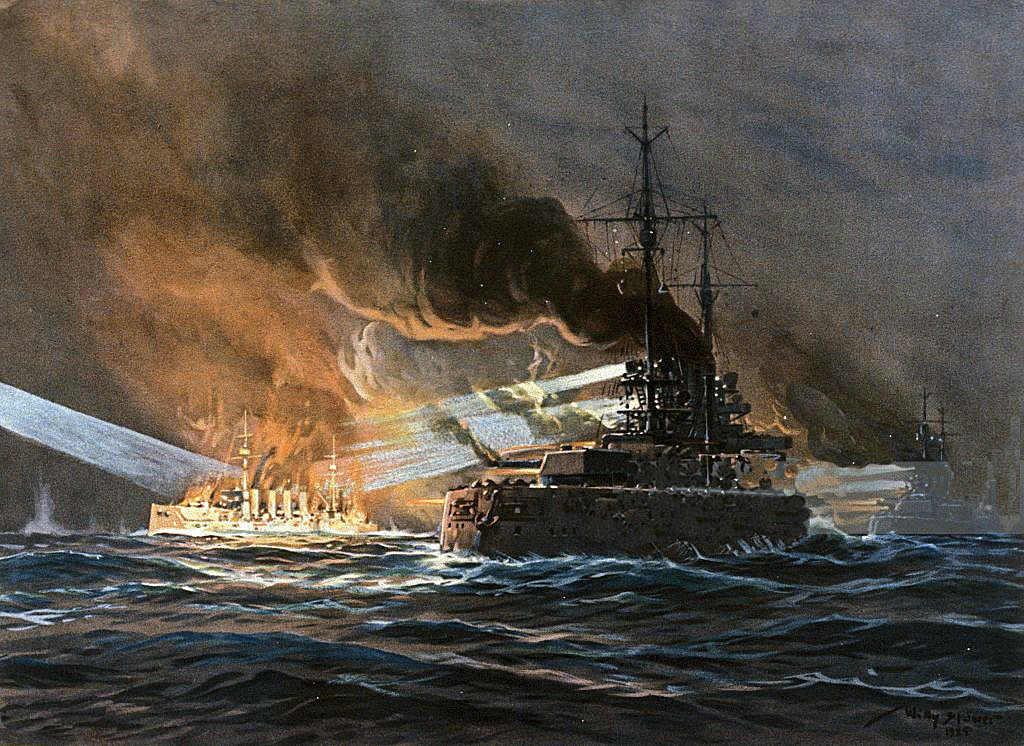
Destruction of the British Armoured Cruiser HMS Black Prince during the night of 31st May 1916 at the Battle of Jutland: picture by Willy Stoewer
HMS Ardent:
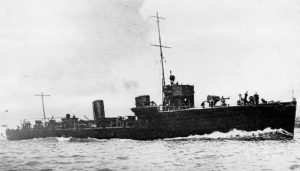
British Destroyer HMS Ardent. Ardent fought at the Battle of Jutland 31st May 1916 in the 4th Flotilla being sunk during the night action
Ardent then came up with the German Fleet and immediately attacked, firing a torpedo. Four German battleships turned their searchlights on Ardent before subjecting her to a storm of shellfire at point blank range. The German fleet sailed on into the night leaving Ardent to sink with the loss of her crew, other than her captain and one sailor. The Fourth Flotilla had been destroyed.
The British battle fleet continued to steam to the south while these actions were fought. The signs of star shells, explosions and flashes of searchlights on their starboard beam and then behind them being attributed to the actions of British light cruisers repelling attacks on the rear of the fleet. None of the battleship captains and admirals realised that the fighting was caused by the passage of the German fleet across the British rear.
The only British battleship that was given cause to realise what was in fact happening was HMS Malaya. Malaya saw a torpedo strike a German ship which in the explosion she identified as the leading ship of the Westfalen class of German battleships (the ship did not sink). This information was not passed to Jellicoe. The British battleships continued to steam south while the British destroyers fought the unequal battle against the German High Seas Fleet as it passed across the rear of Jellicoe’s battle fleet.
At around 11.30am Jellicoe received a signal from the Admiralty giving intercepted signals sent by Scheer. The first at 9.6pm requested an airship reconnaissance of the Horn Reefs first thing in the morning. The other signals ordered the German fleet to sail on a course south south-east ¾ east at 16 knots with Hipper’s battle cruisers in the rear.
Jellicoe did not consider that this information revealed that the German fleet was anywhere other than in front of him and continued on his southerly course.
Two further messages, one from Goodenough, finally sent via HMS Nottingham, and the other from HMS Birmingham seemed to confirm to Jellicoe that the German ships engaging the British ships in the rear were only light cruisers and destroyers. The message from Birmingham identified German battle cruisers but gave their course as south, which was correct at the time of observation but was at the time when the German ships deviated from Scheer’s ordered course and before he ordered them back to the easterly course.
No report of the 4th Flotilla’s final attack on the German battle fleet reached Jellicoe leaving him to assume that the rumpus on the horizon was a further episode in the engagements between ‘light forces’.
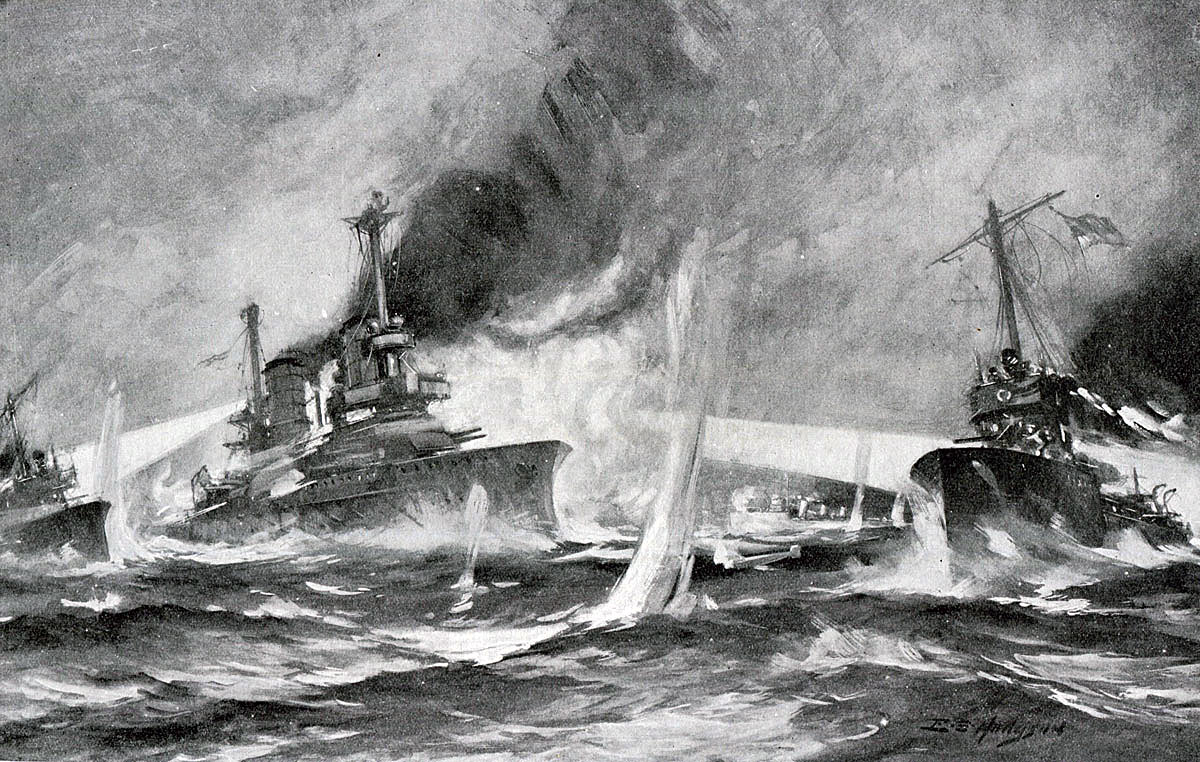
British 13th Flotilla Destroyers attacking the German Battleships in the early hours of 1st June 1916 Battle of Jutland
The engagement with 13th Flotilla, the Harwich 9th Flotilla and the 12th Flotilla:
During the 14th Flotilla action shells were overshooting and falling on the next British force to the east, the 13th Flotilla led by HMS Champion. Champion veered further to the east and forced the Harwich and 12th Flotilla destroyers also to veer to the east.
This left a gap into which the German Fleet sailed and passed through.
Two of the 13th Flotilla destroyers which did not see the turn continued on and came into contact with the German light cruisers Frankfurt and Pillau, escaping under a heavy fire.
The 12th Flotilla turned onto a north-easterly course and did not resume steaming south until 12.20am.
The Harwich destroyers led by Commander Goldsmith in HMS Lydiard continued south-west at high speed in the expectation of encountering the German fleet and were joined by a number of destroyers from the 13th Flotilla which had not realised that Champion had turned away and had lost her: Lydiard, Liberty, Landrail, Laurel of the 9th Flotilla and Morris, Termagent and Turbulent of the 10th Flotilla and Narissa, Nicator, Narborough, Pelican and Petard of the 13th Flotilla.
Goldsmith’s course was at right angles to the German and he passed across their path before the German fleet came up.
The two destroyers at the end of the line, Petard and Turbulent, saw the German ships. Petard had fired all her torpedoes and could only escape into the dark. Turbulent was run down by a German battleship and lost with all hands.
Scheer’s fleet had passed through the massed British destroyers and was making off towards the Horn Reef.
The German destroyers had even less success. Scheer had ordered his destroyers to find the British battle fleet and deliver torpedo attacks on it during the night. The German destroyers mounted no attacks.
1st June 1915:
The first glimmers of dawn came around 2am on 1st June 1915. The weather was deteriorating with increasing mist and rising winds. Disabled ships were forced to cope with heavier seas.
The night actions had seen the British destroyers engaged use up most of their torpedoes and the flotillas dispersed. Ardent and Fortune had sunk. Tipperary was sinking. Sparrowhawk was disabled.
In the German fleet the light cruisers Elbing and Rostock were abandoned and sinking as was the battle cruiser Lützow, Admiral Hipper’s flagship.
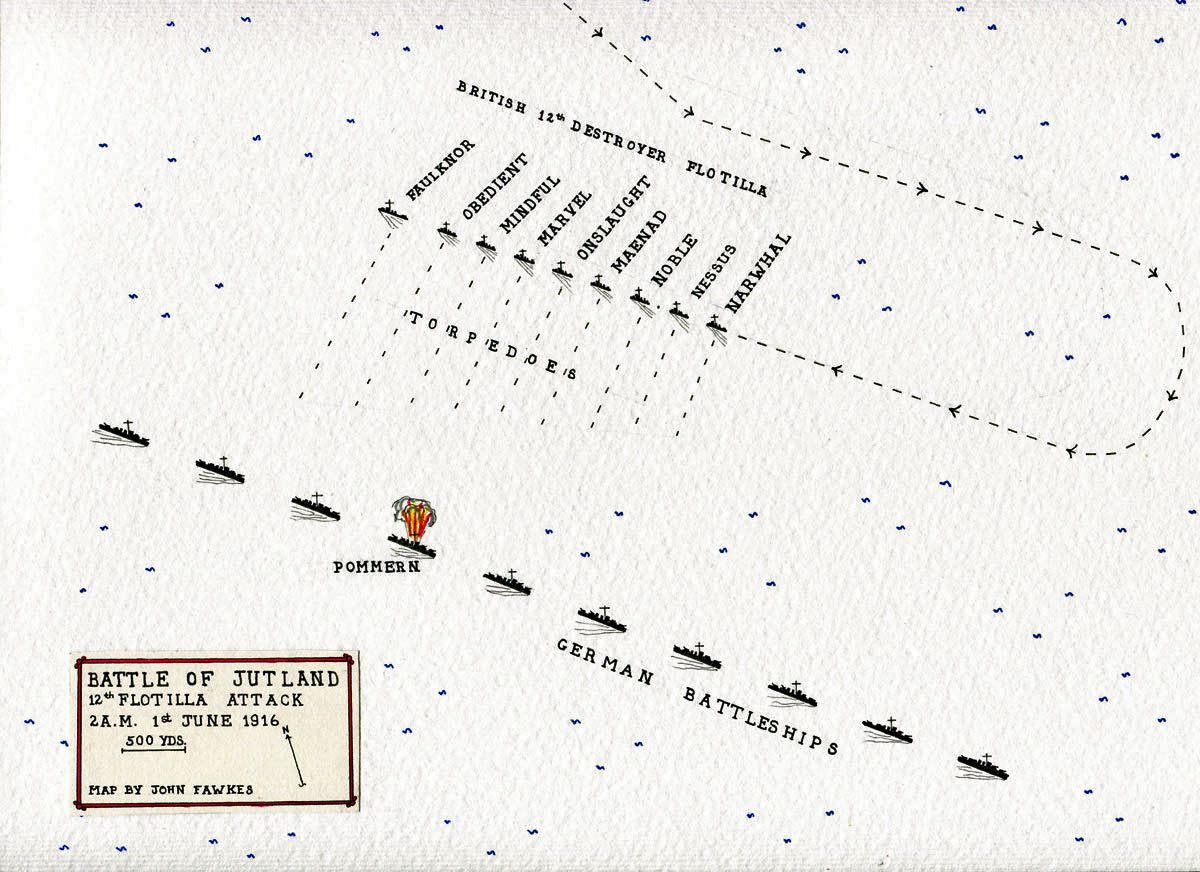
Plan showing the British 12th Destroyer Flotilla’s attack at dawn 1st June 1916 on the German Battle Line during the Battle of Jutland. In the attack the German pre-Dreadnought SMS Pommern was sunk with all hands. The order of the German Battleships was uncertain as ships had been forced to pull out of the line during the night to avoid torpedoes and then re-enter where there was a space: plan by John Fawkes
The British 12th Flotilla’s Dawn Attack:
The only British destroyer flotilla capable of action was the 12th. After being forced to the north north-east by Champion’s swerve this force was racing south again.
The force comprised; Captain Stirling in HMS Faulknor leading, on the starboard wing 1st Division, Obedient, Mindful, Marvel and Onslaught, on the port wing 2nd Division, Maenad, Narwhal, Nessus and Noble, astern Marksman, Opal, Menace, Munster and Mary Rose.
The destroyers were all 34 knot ships of the most modern type with four torpedo tubes and as yet unengaged.
At 1.45am in the first glimmerings of daylight Captain Sterling saw a line of ships on his starboard bow on a south-easterly course. Once nearer Sterling saw that the ships were the German battleships. Sterling altered course to run parallel to the German fleet and ordered Obedient to attack with the 1st Division. He signalled to Jellicoe that German battleships were in sight and that he was attacking.
The German line now disappeared having seen the approaching destroyers and turned to starboard in a zig-zag pattern.
Sterling increased speed to 25 knots on the same course and did a U turn to deliver his attack from in front. As he expected, the German battleships came back into view having resumed their course.
The German ships were seen to be ‘Kaiser’ battleships in the van with older battleships in the rear. During the night the German ships had become muddled up due to the need to turn out of line to avoid torpedoes and re-joining the line where they could find a space.
It was sufficiently light to make the powerful searchlights ineffective and the swirling mist made the destroyers difficult to see. Nevertheless a storm of shellfire was opened on the British ships by the German battleships and light cruisers accompanying them.
Faulknor fired two torpedoes at the second and third ships in the German line. Obedient fired two torpedoes and Marvel and Onslaught fired four each. Mindful was slowed by boiler trouble and being masked by the others was unable to fire.
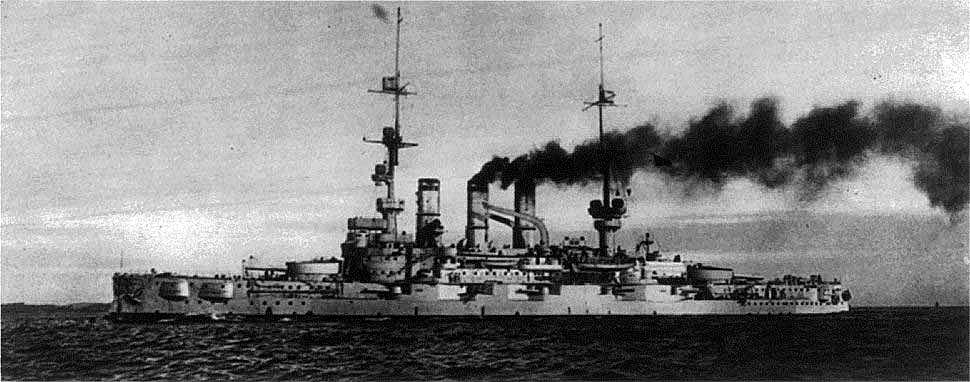
German Battleship SMS Pommern torpedoed in the early hours of 1st June 1916 Battle of Jutland by British 12th Destroyer Flotilla with the loss of her crew
There was a terrific explosion and the German pre-Dreadnought battleship Pommern blew up and sank with the loss of her entire crew. Another battleship was hit but it is unclear which and it did not sink.
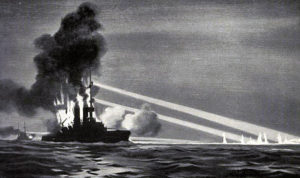
German Battleship SMS Pommern being torpedoed in the early hours of 1st June 1916 Battle of Jutland by British 12th Destroyer Flotilla with the loss of her crew
The attacking British destroyers escaped largely unscathed except for Onslaught struck by shellfire on the bridge and her captain and first lieutenant killed (the ship was sailed back to Rosyth by the surviving RNR sub-lieutenant and a midshipman).
Dawn was coming and the German High Seas Fleet was still thirty miles short of the Horn Reefs light vessel. In spite of the need to press on, the attack by Stirling’s destroyers forced the German fleet to turn away.
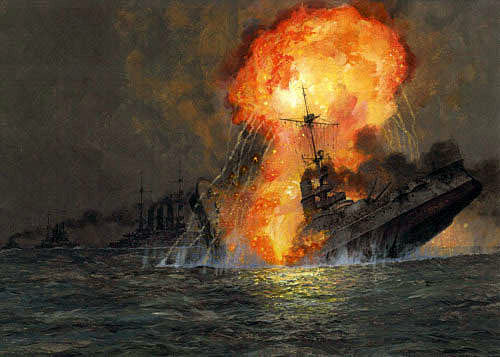
German Battleship SMS Pommern explodes and sinks with the loss of her crew at the Battle of Jutland on 31st May 1916
This turn caused the German ships to avoid yet another attack by British ships. HMS Champion was returning south with the destroyers Obdurate and Moresby.
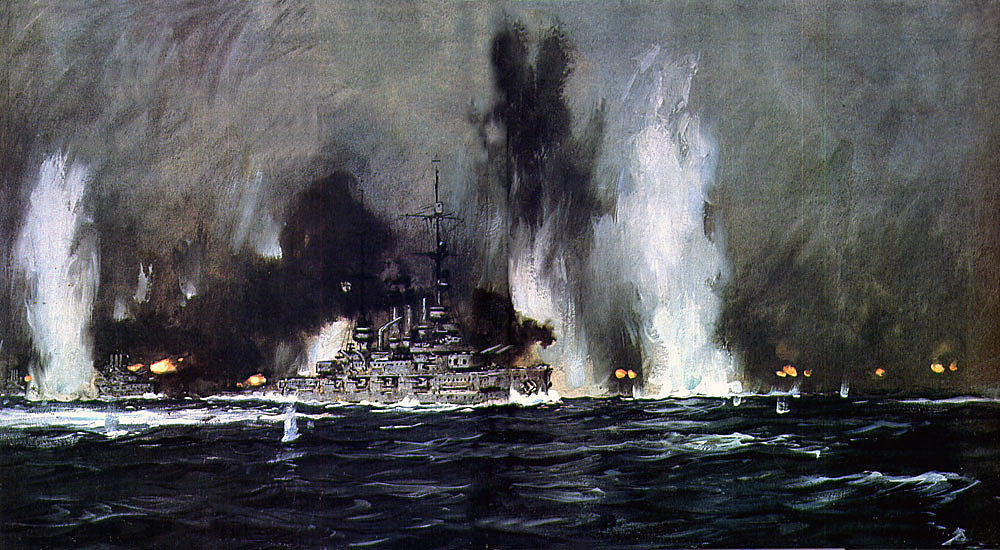
German High Seas Fleet during the night action Battle of Jutland 31st May 1916: picture by Claus Bergen
At 2.15pm Champion turned west towards the sound of firing. The wandering Marksman joined the line. After heading south Champion turned east. This caused the ships she led to miss the German fleet now back on its course south-east, although the rear destroyer Moresby caught sight of four pre-Dreadnoughts about 4,000 yards away (2 ½ miles) moving at full speed.
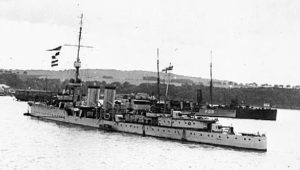
British Flotilla Leader HMS Champion. Champion fought at the Battle of Jutland 31st May 1916 as leader of the 13th Destroyer Flotilla
Marksman fired her last torpedo at the German battleships but struck and sank a German destroyer V4.
The German fleet was now clear of the units of the Grand Fleet and able to make the Horn Reefs and head for its home harbours.
Jellicoe, with no reliable information as to the whereabouts of the German Fleet, was diverted to the west south-west by firing which turned out to be Indomitable and some British light cruisers firing at a German airship.
At 4.30pm with his battleships in cruising order Jellicoe began the journey northwards and home. He signalled to his ships “Enemy fleet has returned to harbour”. The Battle of Jutland was over.

German Battleship SMS Thuringen firing on HMS Black Prince during the night action Battle of Jutland 31st May 1916
The previous battle of the First World War is the Battle of Jutland Part III: Clash between British and German Battle Fleets during the evening 31st May 1916
The next battle of the First World War is the Battle of Jutland Part V: Annexe
